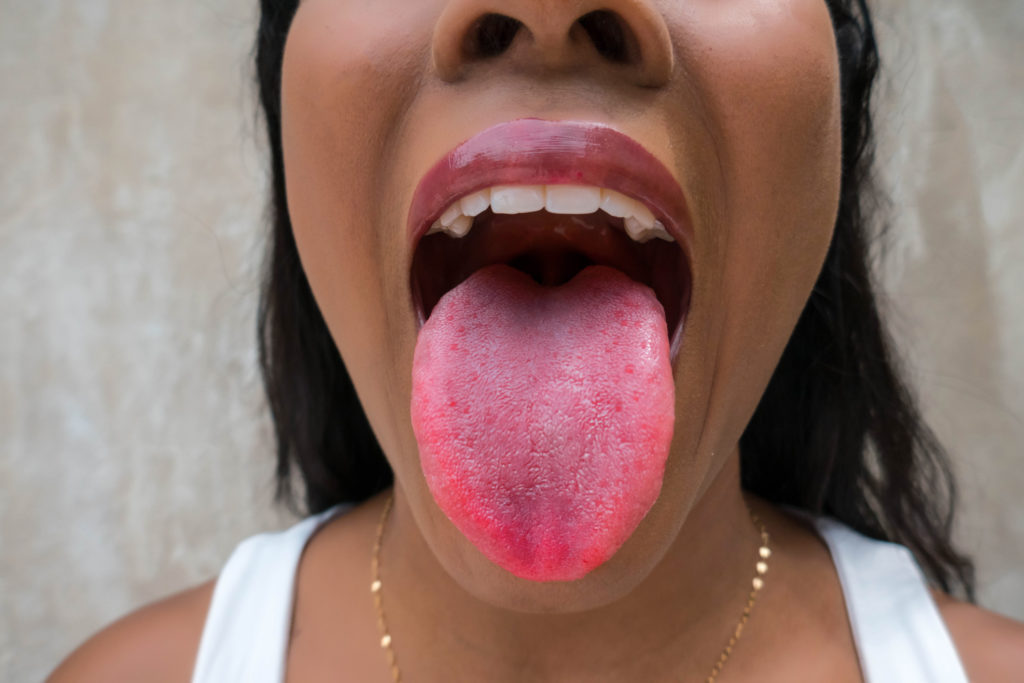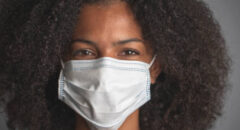
Your body is connected more than you may think. Doctors have found that you can find out a lot more about your own body by looking at other parts, including your tongue. Take a look at your tongue and see if you have any of these symptoms. It could help you in the long run.
You May Have: White tongue
Does your tongue have white spots? A number of things that can cause a whitish coating or white spots on the tongue, including:
Leukoplakia – This condition causes cells in the mouth to grow too much. That leads to the formation of white patches inside the mouth, including on the tongue. Although not dangerous on its own, leukoplakia can be a precursor to cancer. So it is important for your dentist to find the cause of white patches on your tongue. Leukoplakia can develop when the tongue has been irritated, and it is often found in people who use tobacco products.
Oral thrush – Also known as candidiasis, oral thrush is a yeast infection inside the mouth. The condition brings on white patches that are often cottage cheese-like in consistency on the surfaces of the mouth and tongue. Oral thrush is most commonly seen in infants and older people, especially denture wearers, or in people with weakened immune systems. People with diabetes and people taking inhaled steroids for asthma or lung disease can also get thrush. Oral thrush is more likely to happen after the use of antibiotics, which may kill the “good” bacteria in the mouth. Eating plain yogurt with live and active cultures may help restore the proper fauna in your mouth. Also, medications may be used to combat the infection.
Oral lichen planus – A network of raised white lines on your tongue with a lace-like appearance can be a sign of this condition. Doctors often can’t pinpoint its cause, but it usually gets better on its own. You can do some things that might help: Practice proper dental hygiene, avoid tobacco, and cut back on foods that irritate your mouth.
You May Have: Atrophic glossitis
Atrophic glossitis is a condition in which the tongue is missing some or all of its papillae, making its usually rough surface smooth.
As a result, if you have this condition, you may have problems tasting food. In addition, you may also experience pain, burning, and numbness in the tongue.
Several underlying causes can potentially cause atrophic glossitis. These include:
- Nutrient deficiency, such a lack of sufficient pyridoxine, folic acid, riboflavin, niacin, vitamin B12, zinc, iron, and vitamin E
- protein deficiency
- candidiasis
- Helicobacter pylori infection
- Insufficient saliva production
You May Have: Black tongue
A black tongue is usually a harmless condition that can be caused by medications, smoking, poor oral hygiene, a soft diet, or dry mouth. A black tongue is usually associated with elongated tongue papillae and thus, it is called “black hairy tongue” (lingua villosa nigra). The cause is thought to be a change in the normal bacteria in the mouth after antibiotic treatment or the use of products that contain bismuth such as Pepto-Bismol. (“Hairy tongue” by itself can also be white or tan.)
Treatment of black hairy tongues may involve improving one’s diet, smoking cessation, and improved oral hygiene (including gently brushing with a soft-bristled toothbrush or scraping the tongue).
You May Have: COVID Tongue
In addition to the growing list of strange possible symptoms of the new coronavirus that include fever, congestion issues, loss of taste and smell, etc. The newest symptom some are calling: “Covid tongue.”
A British researcher who is helping to track Covid-19 warning signs is reporting more cases of infected people complaining of tongue discoloration, enlargement and other mouth problems.
“Seeing increasing numbers of Covid tongues and strange mouth ulcers…” Tim Spector, a professor of genetic epidemiology at King’s College London, tweeted.
Spector believes more than a third of COVID-19 patients, 35 percent, have non-classic symptoms of the disease in the first three days, so it’s important to draw attention to skin rashes, Covid toes and other warning signs that “go ignored,” he wrote.
He estimates fewer than 1 in 500 patients have “COVID tongue.” The main symptoms he hears about are a “furry coating” of the tongue that can be white or yellow and can’t be brushed away, and a scalloped tongue. The condition can be painful.
READ: Experts Explain Why Fully Vaccinated People are Still Getting Infected With COVID-19
“It’s a good reminder that there are so many different manifestations of this virus rather than just the classical ones,” Spector, who is the lead investigator of the ZOE COVID Symptom Study that allows people to report symptoms via an app, told NBC News.
“The whole question of why we have this huge range of symptoms of the virus is still unknown.”
Until there’s more data, it’s too early to add “COVID tongue” to any official symptom lists, but dentists, oral surgeons and other doctors looking inside people’s mouths should be aware it might be one of the early signs of infection, he noted.
Other researchers have also reported tongue and mouth symptoms linked with the new coronavirus.
When doctors studied 666 patients with Covid‐19 in Spain, more than a tenth of them — 78 — exhibited “oral cavity findings,” according to a study published in the British Journal of Dermatology.
Of that group, 11 percent had inflammation of the small bumps on the tongue’s surface; 6 percent had a swollen and inflamed tongue with indentations on the side; 6 percent had mouth ulcers; 4 percent had “patchy” areas on the tongue; and 4 percent had tissue swelling in the mouth.
READ: These Are ALL the Ingredients of Pfizer’s COVID Vaccine
Pictures of COVID Tongue
People on social media are starting to speak out as well.
In the COVID-19 Facebook group Survivor Corps, a grassroots organization of COVID-19 patients, many have shared oral symptoms that they say coincided with their testing positive for the coronavirus. Carol Van Der Spuy, a marketing manager in Cape Town, South Africa, said she noticed the symptoms when she tested positive for COVID-19 a second time. “I had big patches on [my tongue] which were a different color,” she says. “It almost looks like it has been ‘burned clean.’”
New Yorker Martha Barrera says she developed symptoms two weeks after getting COVID-19 in March. “My tongue swelled up,” she tells Yahoo Life. “It was painful and so sensitive and I could not tolerate anything cold or hot. It also was white … didn’t matter how many times I brushed, the color was different. The doctor didn’t know what to do, so he prescribed thrush medication for three weeks. Ten months later, my tongue swells up out of the blue. I still have issues.”
Signs that are NOT ‘COVID Tongue’
There are a number of strange signs and symptoms that can appear on your tongue. At first glance, these symptoms may seem scary, but it could be something totally different.
Tongue Texture
A smoother-than-normal tongue might be a sign you’re skimping on nutrients like iron, folic acid and vitamin B12, the National Institutes of Health reported. Alternately, if skin cells build up on the normal bumps of the tongue, the tongue can have a “hairy” or darker-than-normal appearance. This isn’t usually a medical issue, but rather a stain from food, bacteria or even tobacco use.
If the tongue is red and blistered, it’s probably too dry, a sign that you might not be making enough saliva, which could in turn be a side effect of some blood pressure or allergy meds, ABC News reported.
Tongue Color
When your tongue is not its normal pink color, you could have an underlying health issue. Below are other colors your tongue may be and what they could mean.
Red. A red (not dark pink) tongue could indicate as something as simple as a B vitamin deficiency, which can be remedied by supplementation. Scarlet fever, eczema, and Kawasaki disease may also cause your tongue to turn red. Red patches with white borders along your tongue is a rare, but harmless condition called geographic tongue.
Purple. Heart problems and poor overall blood circulation may cause your tongue to turn purple. A purple tongue may also be seen in Kawasaki disease.
Blue. Blue tongue may be indicative of poor oxygen circulation in the blood. This may be attributed to lung problems or kidney disease.
Yellow. Your tongue may have a yellow appearance if you smoke or use chewing tobacco. Sometimes jaundice and psoriasis may also cause yellow tongue.
Gray. Sometimes digestive issues may cause your tongue to turn gray. Peptic ulcers or eczema may also be to blame.
White. A white tongue is usually caused by white patches that grow on the surface. These are usually caused by fungal infections, such as oral thrush. Antifungal medications can clear these patches up. White tongue may also be caused by benign conditions such as leukoplakia or oral lichen planus, which creates the appearance of white lines. Sometimes leukoplakia may become cancerous.
Brown. This is usually harmless and caused by what you eat and drink. However, tobacco use is another cause of brown tongue, a harmful habit that could potentially lead to signs of oral cancer in the tongue, such as sores.
Black. A dark brown to black tongue is most commonly attributed to bacteria from poor oral hygiene habits. Diabetes is another potential cause of a black tongue. Sometimes your papillae can multiply and look hairy, which is a characteristic of a benign condition called hairy black tongue.
Other related articles








